Caryn
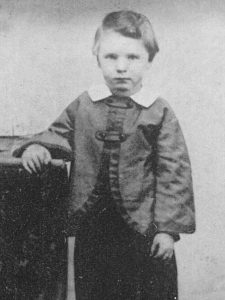 When we think of the White House, we seldom think of death. Oh, there have been presidents who were assassinated, or died while in office, but mostly not in the White House. It is too well guarded, and an ill president usually was taken to a hospital. Nevertheless, death has visited the White House, and the case I am referring to was not a president, but rather his son. Abraham Lincoln is my 7th cousin thrice removed, making his children, my 7th cousins 4 times removed. Lincoln married Mary Todd on November 4, 1842, in Springfield, Illinois. They were the parents of four sons Robert Todd Lincoln was born in 1843 and Edward Baker “Eddie” Lincoln in 1846. Edward died on February 1, 1850, in Springfield, probably of Tuberculosis. William Wallace “Willie” Lincoln was born on December 21, 1850, and died of a Typhoid Fever on February 20, 1862. The Lincolns’ fourth son, Thomas “Tad” Lincoln, was born on April 4, 1853, and died of heart failure at the age of 18 on July 16, 1871. While three of the four boys died in childhood, only one, Willie passed away in the White House.
When we think of the White House, we seldom think of death. Oh, there have been presidents who were assassinated, or died while in office, but mostly not in the White House. It is too well guarded, and an ill president usually was taken to a hospital. Nevertheless, death has visited the White House, and the case I am referring to was not a president, but rather his son. Abraham Lincoln is my 7th cousin thrice removed, making his children, my 7th cousins 4 times removed. Lincoln married Mary Todd on November 4, 1842, in Springfield, Illinois. They were the parents of four sons Robert Todd Lincoln was born in 1843 and Edward Baker “Eddie” Lincoln in 1846. Edward died on February 1, 1850, in Springfield, probably of Tuberculosis. William Wallace “Willie” Lincoln was born on December 21, 1850, and died of a Typhoid Fever on February 20, 1862. The Lincolns’ fourth son, Thomas “Tad” Lincoln, was born on April 4, 1853, and died of heart failure at the age of 18 on July 16, 1871. While three of the four boys died in childhood, only one, Willie passed away in the White House.
Disease was a scary thing in those days, because many serious diseases, which we have cures for now, were a death sentence in those days. Little Willie Lincoln had contracted Typhoid Fever. Typhoid fever, also known simply as typhoid, is a bacterial infection due to Salmonella Typhi that causes symptoms which may vary from mild to severe and usually begin six to thirty days after exposure. The disease was all over Washington DC, and 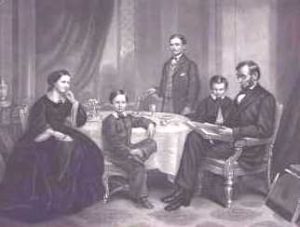 even the White House was not safe from it’s deathly grip. In fact, Willie was not the only one to have it. His brother, Tad was in bed just down the hall, with the same illness. Tad would survive, but I have to wonder if his heart was not severely weakened by the disease, because he passed away just nine years later of heart failure. On February 20, 1862, little 11 year old Willie succumbed to the Typhoid Fever at 5:00pm. His parents were with him, and Abraham Lincoln said, “My poor boy, he was too good for this earth. God has called him home. I know that he is much better off in heaven, but then we loved him so. It is hard, hard to have him die!” Mary watched him bury his head in his hands, “his tall frame convulsed with emotion.” At the foot of the bed she stood “in silent, awe-stricken wonder,” marveling that so rugged a man could be so moved. “I shall never forget those solemn moments — genius and greatness weeping over love’s idol lost.” President Lincoln then walked down the hall to his secretary’s office. He startled the half-dozing secretary with the news: “Well, Nicolay, my boy is gone — he is actually gone!” John Nicolay recalled seeing his boss burst into tears before entering his own office. I think I have to agree with Mary. When we think of Abraham Lincoln, we think of a strong man, but if we think about it, he also had a softer side, and he loved children.
even the White House was not safe from it’s deathly grip. In fact, Willie was not the only one to have it. His brother, Tad was in bed just down the hall, with the same illness. Tad would survive, but I have to wonder if his heart was not severely weakened by the disease, because he passed away just nine years later of heart failure. On February 20, 1862, little 11 year old Willie succumbed to the Typhoid Fever at 5:00pm. His parents were with him, and Abraham Lincoln said, “My poor boy, he was too good for this earth. God has called him home. I know that he is much better off in heaven, but then we loved him so. It is hard, hard to have him die!” Mary watched him bury his head in his hands, “his tall frame convulsed with emotion.” At the foot of the bed she stood “in silent, awe-stricken wonder,” marveling that so rugged a man could be so moved. “I shall never forget those solemn moments — genius and greatness weeping over love’s idol lost.” President Lincoln then walked down the hall to his secretary’s office. He startled the half-dozing secretary with the news: “Well, Nicolay, my boy is gone — he is actually gone!” John Nicolay recalled seeing his boss burst into tears before entering his own office. I think I have to agree with Mary. When we think of Abraham Lincoln, we think of a strong man, but if we think about it, he also had a softer side, and he loved children.
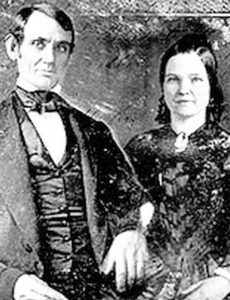 Willie Lincoln was a favorite around the White House. In the words of a government official’s wife, “The White House is sad and still, for its joy and light have fled with little Willie. He was a very bright child, remarkably precocious for his age, and had endeared himself to every one who knew him.” Mary Lincoln’s cousin said he was “noble, beautiful…a counterpart of his father, save that he was handsome.” Mary herself called him the “idolized child, of the household.” It’s somewhat strange to think that such a large household as the White House, with all of it’s staff who work there, could be so changed by the death of a child, but Willie Lincoln was not an ordinary child. Had he been, he might not have come to the attention of everyone in the White House. Most of us know who the first children are but the White House staff knew Willie Lincoln and dearly loved him. As dates in history go, while this little boy was not an important man is the way we think of that today, he had a impact that went far beyond his short time on this earth, and his dying day was one that saddened a nation.
Willie Lincoln was a favorite around the White House. In the words of a government official’s wife, “The White House is sad and still, for its joy and light have fled with little Willie. He was a very bright child, remarkably precocious for his age, and had endeared himself to every one who knew him.” Mary Lincoln’s cousin said he was “noble, beautiful…a counterpart of his father, save that he was handsome.” Mary herself called him the “idolized child, of the household.” It’s somewhat strange to think that such a large household as the White House, with all of it’s staff who work there, could be so changed by the death of a child, but Willie Lincoln was not an ordinary child. Had he been, he might not have come to the attention of everyone in the White House. Most of us know who the first children are but the White House staff knew Willie Lincoln and dearly loved him. As dates in history go, while this little boy was not an important man is the way we think of that today, he had a impact that went far beyond his short time on this earth, and his dying day was one that saddened a nation.
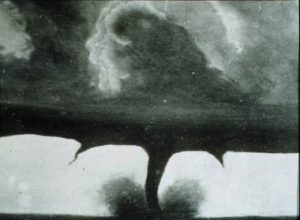 These days, tornado watches and warnings are a normal part of life. They may not happen every day, but when they do sound, we know what to do to stay as safe as possible. The warnings don’t always mean that there are zero deaths from a tornado, but they do help. Unfortunately, the tornado warning sirens, Doppler radar, and television warnings did not exist in 1884. In those days, people had to rely on the skies to tell them what was coming, and as most of us know, that is not always an easy task. In fact, it has taken hundreds of years to even begin to come close to perfecting a system whereby the public could be warned of approaching severe weather, and even then, it hasn’t eliminated the deaths that can occur from these storms.
These days, tornado watches and warnings are a normal part of life. They may not happen every day, but when they do sound, we know what to do to stay as safe as possible. The warnings don’t always mean that there are zero deaths from a tornado, but they do help. Unfortunately, the tornado warning sirens, Doppler radar, and television warnings did not exist in 1884. In those days, people had to rely on the skies to tell them what was coming, and as most of us know, that is not always an easy task. In fact, it has taken hundreds of years to even begin to come close to perfecting a system whereby the public could be warned of approaching severe weather, and even then, it hasn’t eliminated the deaths that can occur from these storms.
One of the largest and most widespread tornado outbreaks in American history happened at a time when warnings did not exist. It happened on this day February 19, 1884, and into February 20, 1884. The precise number of tornadoes, as well as fatalities incurred during the outbreak remains unknown. The outbreak was nicknamed “Enigma outbreak” and is well known by that name. Research of newspaper reports and governmental studies published in the aftermath reveals tornadoes, or in reality, long-track tornado families, struck Alabama, 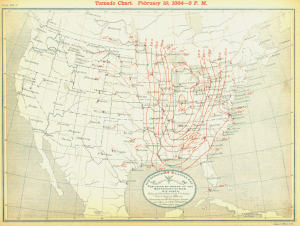 Georgia, Illinois, Indiana, Kentucky, Mississippi, North Carolina, South Carolina, Tennessee and Virginia. It is estimated that at least 50 tornadoes struck those states that day. Some events that had been counted as tornadoes in initial studies, such as those by John Park Finley, were actually downbursts, especially in northern and northeastern portions of the outbreak. Nevertheless, the damage done was nothing to be overlooked.
Georgia, Illinois, Indiana, Kentucky, Mississippi, North Carolina, South Carolina, Tennessee and Virginia. It is estimated that at least 50 tornadoes struck those states that day. Some events that had been counted as tornadoes in initial studies, such as those by John Park Finley, were actually downbursts, especially in northern and northeastern portions of the outbreak. Nevertheless, the damage done was nothing to be overlooked.
The majority of the reported tornadic activity was seen across Alabama, Georgia, South Carolina and North Carolina, which were all struck severely by multiple waves of tornado families. In the Southeast, the outbreak began during the late morning in Mississippi, preceded by severe thunderstorms in Louisiana. Shortly thereafter, the outbreak widened and intensified, progressing from Alabama to Virginia between noon and midnight. In addition to the outbreak, wind damage, flash floods, with homes swept away by water in Louisville, Kentucky, New Albany, Indiana, and Jeffersonville, Indiana and other towns along the Ohio River, and Derecho-like effects in the Ohio Valley were also reported in published accounts of the outbreak. In case you didn’t know, a Derecho is a widespread, long-lived, straight-line wind storm that is 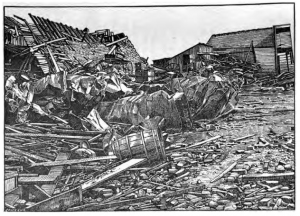 associated with a land-based, fast-moving group of severe thunderstorms. In addition to that, blizzard conditions occurred in the eastern Midwest, as a part of this storm series. According to an article appearing in the Statesville, North Carolina Landmark three days later, the damage tally in Georgia alone was estimated to be $1 million, in 1884 dollars. Today, the damage would have been approximately $23,660,667. That is an astounding figure, and that is just the property damage numbers. Loss of life simply cannot be measured in money. In fact, the greatest mystery surrounding this horrific event is the possibility that, in all likelihood, as many as 1,200 people lost their lives that day at the hands of the 1884 Enigma Tornado Outbreak.
associated with a land-based, fast-moving group of severe thunderstorms. In addition to that, blizzard conditions occurred in the eastern Midwest, as a part of this storm series. According to an article appearing in the Statesville, North Carolina Landmark three days later, the damage tally in Georgia alone was estimated to be $1 million, in 1884 dollars. Today, the damage would have been approximately $23,660,667. That is an astounding figure, and that is just the property damage numbers. Loss of life simply cannot be measured in money. In fact, the greatest mystery surrounding this horrific event is the possibility that, in all likelihood, as many as 1,200 people lost their lives that day at the hands of the 1884 Enigma Tornado Outbreak.
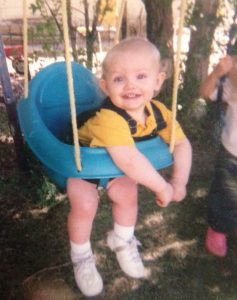
 As their youngest child becomes a teenager, parents suddenly have these bittersweet moments. They are proud of the young person their baby has grown into, but they know they will forever miss the baby they once were. That is the very feeling expressed by my niece, Machelle Moore, as she prepares to celebrate her youngest son, Easton Moore’s birthday today. Easton was a cute little boy, and his big brother, Weston Moore was so excited to have a brother. I remember Easton as a smiley little guy with things to do, places to go, and people to see…even if he never left to house. He was busy. No sitting still for him.
As their youngest child becomes a teenager, parents suddenly have these bittersweet moments. They are proud of the young person their baby has grown into, but they know they will forever miss the baby they once were. That is the very feeling expressed by my niece, Machelle Moore, as she prepares to celebrate her youngest son, Easton Moore’s birthday today. Easton was a cute little boy, and his big brother, Weston Moore was so excited to have a brother. I remember Easton as a smiley little guy with things to do, places to go, and people to see…even if he never left to house. He was busy. No sitting still for him.
Easton, like most elementary school kids these days, got into Lego Robotics, and really enjoyed that, as did his family. His mom, Machelle Moore tells me that phase is winding down now, and it makes her feel sad, because her little boy is growing up. Yesterday, Easton told her, “Today is my birthday eve.” I’m sure her heart jumped a little bit, because her youngest boy was almost a teenager. The time had flown by so fast, and all she could  think of is, “Where is the brake pedal?” I knew just how she feels. Our time with our little ones is just a drop in the bucket of life, and all too soon it is behind us. Nevertheless, Easton made her feel better when he said, “Don’t worry Mom, I am still gonna be your sweet boy when I am 13.” That little jump in her heart must have turned into a lump in her throat, because it was tough holding back the tears.
think of is, “Where is the brake pedal?” I knew just how she feels. Our time with our little ones is just a drop in the bucket of life, and all too soon it is behind us. Nevertheless, Easton made her feel better when he said, “Don’t worry Mom, I am still gonna be your sweet boy when I am 13.” That little jump in her heart must have turned into a lump in her throat, because it was tough holding back the tears.
Of course, thirteen isn’t twenty five, and Easton still has a few “kid years” left to enjoy. These days he is heavily into Nerf guns, and even has a Nerf crossbow. His dad, Steve Moore loves guns, and while Easton’s guns are Nerf guns, it is still a passion they can share. They have even re-worked the Nerf guns, so they will get more distance. Guns are a passion that Easton is not likely to outgrow…although the gun type will progress into real guns at some point. Still, I can see them “shooting” each other with Nerf guns far into the future, because lets face it, men never really grow up. While Easton’s early years focused a lot on his mom as little ones often do, he latter years will likely follow along the lines of activities with his dad. Not that he won’t always cherish his mom, because he will, but boys just tend to do more things with their dads as they get older. However, Machelle likes doing the things Steve likes, so I’m sure she will be along for those activities too.


Easton is growing up, and that’s for sure, but as I’ve said, there are still a few years of boyhood left, and he still likes doing the goofy things that most boys do. Things that might gross girls out, are the coolest things to a boy. Most kids like bubble gum and blowing bubbles is the biggest part of the fun, but it takes the little kid in a person to want to film the process, and take special notice of the part where the bubble meets the face. Yes, the little boy is Easton is alive and well, and as long as he enjoys doing the goofy things, that little boy always will be. Today is Easton’s 13th birthday. Happy birthday Easton!! Have a great day, and don’t grow up too fast!! We love you!!
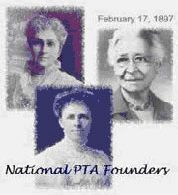 For much of my grandsons, Chris and Josh Petersen’s elementary school years at Pineview Elementary School, my daughter, Corrie Petersen was a member of and finally President of the Pineview Order of Parents and Instructors (POPI), which was basically Pineview Elementary School’s Parent Teacher Association (PTA). It was a big, and often thankless job, and I was always proud of the way she handled it. We have all heard of the PTA, but I never really knew how it got started. It actually has a very interesting history. Of course, when the schools in our country began, there was no real program that connected parents and teachers. I suppose that since many of these schools were small country schools, everyone knew the teachers anyway. As time went on, parents and especially moms, who were mostly stay-at-home moms in those days began to take an interest in what was being taught. The biggest problem they faced was that for many years, women couldn’t vote. Their voices were not heard in these matters.
For much of my grandsons, Chris and Josh Petersen’s elementary school years at Pineview Elementary School, my daughter, Corrie Petersen was a member of and finally President of the Pineview Order of Parents and Instructors (POPI), which was basically Pineview Elementary School’s Parent Teacher Association (PTA). It was a big, and often thankless job, and I was always proud of the way she handled it. We have all heard of the PTA, but I never really knew how it got started. It actually has a very interesting history. Of course, when the schools in our country began, there was no real program that connected parents and teachers. I suppose that since many of these schools were small country schools, everyone knew the teachers anyway. As time went on, parents and especially moms, who were mostly stay-at-home moms in those days began to take an interest in what was being taught. The biggest problem they faced was that for many years, women couldn’t vote. Their voices were not heard in these matters.
In the late 1800s women still weren’t allowed to vote in elections, and so it would seem that they wouldn’t be able to wield the political power needed to bring about change in the education system. The conventional wisdom of the time was soon to be challenged, however, by two women who first founded National PTA’s predecessor, the National Congress of Mothers. On February 17, 1897, the two founders, Alice McLellan Birney and Phoebe Apperson Hearst, looked out at the 2,000 people from across the country who gathered for the Mothers Congress’ first meeting in Washington DC. It was the beginning of the largest…and now oldest volunteer organization that works exclusively on behalf of children and youth. Sadly, this is a group of people who had even fewer rights at the time than women. In 1919, Selena Sloan Butler dedicated her life to forming an organization which would have the same objectives as the National Congress of Parents and Teachers. She formed the Yonge Street Parent-Teacher Association, which was the first unit of the Georgia Congress of Colored Parents  and Teachers (the precursor of the National Congress of Colored Parents and Teachers). In 1970, when the two groups united to form the National PTA, and the three women were recognized as co-founders.
and Teachers (the precursor of the National Congress of Colored Parents and Teachers). In 1970, when the two groups united to form the National PTA, and the three women were recognized as co-founders.
As the years went by, more women became working moms, and in many ways, the PTA, and the children, have suffered for it. That is why my daughter, who was a working mom too, ended up having to do so much of the work herself. That used to make me angry, but sometimes, you just have to get over things. Corrie’s time in the PTA, like her children’s years in elementary school would come to a close, and someone else would have to step up to the plate, but I know that Corrie will never regret the decision she made to head up the PTA (POPI) at Pineview Elementary School, and I know that I am very proud of her for taking the reigns and getting it done for the kids. Today is the 120th anniversary of this great organization.
 Whether you have called 911 or not, everyone knows what 911 is, and that calling that number will bring immediate help. If you have ever had to use the service, you know how vital it is, but did you know how it got started? Prior to 1968, there was no 911 system in the United States, or really anything like it. If people had an emergency, they dialed “0” for the operator. Of course, the operator was dialed for many other things too, so it was not always the fastest way to get help in an emergency. The Federal Communications Commission (FCC) knew that things had to change.
Whether you have called 911 or not, everyone knows what 911 is, and that calling that number will bring immediate help. If you have ever had to use the service, you know how vital it is, but did you know how it got started? Prior to 1968, there was no 911 system in the United States, or really anything like it. If people had an emergency, they dialed “0” for the operator. Of course, the operator was dialed for many other things too, so it was not always the fastest way to get help in an emergency. The Federal Communications Commission (FCC) knew that things had to change.
They wanted a number that would be easy to remember, and one that had never been used before…like 411 for information. Choosing 911 as the universal emergency number was not an random selection, but it wasn’t a difficult one either. In 1967, the FCC met with AT&T to establish such an emergency number. They wanted a number that was short and easy to remember, but most importantly, they also needed it to be a unique number, and since 911 had never been designated for an office code, area code or service code, that was the number they chose. Still, the system did not start out at the national level.
On February 16, 1968, Alabama Senator Rankin Fite made the first 911 call in the United States in Haleyville, Alabama. The Alabama Telephone Company carried the call. A week later in Nome, Alaska, the 911 system was implemented there. In 1973, the White House’s Office of Telecommunication issued a national statement supporting the use of 911 and pushed for the establishment of a Federal Information Center to assist government agencies in implementing the system. Soon after, the United States Congress agreed to support 911 as the standard emergency number for the nation and passed legislation making 911 the exclusive number for any emergency calling service. A central office was set up by the Bell Telephone System to develop the infrastructure for the system.
After its initial acceptance in the late 1960s, 911 systems quickly spread across the country. By 1979, about  26% of the United States population had 911 service, and nine states had passed legislation for a statewide 911 system. During the latter part of the 1970s, 911 service grew at a rate of 70 new local systems per year, according to the National Emergency Number Association (NENA). Approximately 50% of the United States population had 911 service by 1987. In 1999, about 93% of the nation’s population was covered by 911 service. The number “911” is now the universal emergency number for everyone in the United States. In 2000, approximately 150 million calls were made to 911, according to the NENA. If you were born in the 1960s or later, 911 was ingrained during childhood. For those born prior to 1968, the 911 system has also become second nature.
26% of the United States population had 911 service, and nine states had passed legislation for a statewide 911 system. During the latter part of the 1970s, 911 service grew at a rate of 70 new local systems per year, according to the National Emergency Number Association (NENA). Approximately 50% of the United States population had 911 service by 1987. In 1999, about 93% of the nation’s population was covered by 911 service. The number “911” is now the universal emergency number for everyone in the United States. In 2000, approximately 150 million calls were made to 911, according to the NENA. If you were born in the 1960s or later, 911 was ingrained during childhood. For those born prior to 1968, the 911 system has also become second nature.
 I love looking at the pictures my family posts…especially the kids. They say a picture is worth a thousand words, and that’s true, but sometimes it’s the caption that really grabs me. Such was the case the other day when I looked at this picture posted by my cousin, Grace Oltman. The picture shows the smiling faces of her son, Hosea and her sister, Angel Pallas’ daughter, Hazel. These kids never cease to amaze me, because they are just being kids, after all. Grace captioned the picture with, “They will do anything for some candy.” That immediately took me back to the years when my grandchildren were little ones, and we tried so hard, sometimes in vain to get a good picture of the four of them.
I love looking at the pictures my family posts…especially the kids. They say a picture is worth a thousand words, and that’s true, but sometimes it’s the caption that really grabs me. Such was the case the other day when I looked at this picture posted by my cousin, Grace Oltman. The picture shows the smiling faces of her son, Hosea and her sister, Angel Pallas’ daughter, Hazel. These kids never cease to amaze me, because they are just being kids, after all. Grace captioned the picture with, “They will do anything for some candy.” That immediately took me back to the years when my grandchildren were little ones, and we tried so hard, sometimes in vain to get a good picture of the four of them.
As the grandma, it was my idea to do the four of them, and sometimes I think my girls, Corrie Petersen and Amy Royce,  thought I was crazy. In fact, sometimes I thought I was crazy. We tried everything to get them to all four smile at the same time…and I mean we tried everything, including candy, if they cooperated. Sometimes it worked, and sometimes it didn’t. Now, looking at the pictures Grace took…which turned out amazing, by the way, I see what my problem was. She gave them the candy while they had the picture taken. What kid wouldn’t smile with a piece of chocolate in their hand? Oh, if I had only known. Of course, these little kids, Hazel, Hosea, Tenley, and Canaan, as well as cousins, Addilayde and Meadow, are definitely not strangers to the camera. Their parents take lots of pictures of them, and these kids know how to smile for the camera. I think that is why I enjoy looking at all their pictures so much. There is just nothing sweeter than looking at a smiling child…even if it is a candy smile, and even if the candy, cake, or whatever else they may enjoy having, is all over their face.
thought I was crazy. In fact, sometimes I thought I was crazy. We tried everything to get them to all four smile at the same time…and I mean we tried everything, including candy, if they cooperated. Sometimes it worked, and sometimes it didn’t. Now, looking at the pictures Grace took…which turned out amazing, by the way, I see what my problem was. She gave them the candy while they had the picture taken. What kid wouldn’t smile with a piece of chocolate in their hand? Oh, if I had only known. Of course, these little kids, Hazel, Hosea, Tenley, and Canaan, as well as cousins, Addilayde and Meadow, are definitely not strangers to the camera. Their parents take lots of pictures of them, and these kids know how to smile for the camera. I think that is why I enjoy looking at all their pictures so much. There is just nothing sweeter than looking at a smiling child…even if it is a candy smile, and even if the candy, cake, or whatever else they may enjoy having, is all over their face.

Every once in a while, however, even mom’s who take great pictures because the kids are so cooperative, will hit a bit of a snag. Such was the case when Grace took the picture of little Hosea and his little brother Canaan. Hosea was wearing his usual great smile, but Canaan needed a little help. Uh…Grace, I think you forgot the chocolate on this one, but then I guess Canaan was a teeny bit to small for that. Nevertheless, those sad face pictures can be just as cute as the ones that are all smiles. In the end, I had to promise to let my grandkids, Chris Petersen, Shai Royce, Caalab Royce, and Josh Petersen, do one goofy picture in order to get good smiles out of them. I guess that the moral of the story is…whatever works.

 Every year, right before Valentine’s Day, men begin the sometimes stress filled process of making sure that the gift they get for their girl, be it wife or girlfriend, is the right thing. They don’t know if they should get chocolates, flowers, diamonds, stuffed toys, or something else. They just know that they want to make their girl happy. They want her to feel loved. In my almost 42 years of marriage to my husband, Bob Schulenberg, I have received all of the above gifts, and many others, along with a nice dinner out each year to celebrate our love, but I have to say, that while it’s nice to get those things and I love him for doing it, in all reality, it’s not about all those things. It’s about the love we have for each other. In fact, it’s all about the love. Without the love, there is no reason for all the rest of it anyway. Marriages don’t last 42 years just because the husband, wife, or both remembered the special days, although it does help…especially the anniversaries. Nevertheless, it is the love and respect that a couple shows each other in their day to day life that make the marriage great.
Every year, right before Valentine’s Day, men begin the sometimes stress filled process of making sure that the gift they get for their girl, be it wife or girlfriend, is the right thing. They don’t know if they should get chocolates, flowers, diamonds, stuffed toys, or something else. They just know that they want to make their girl happy. They want her to feel loved. In my almost 42 years of marriage to my husband, Bob Schulenberg, I have received all of the above gifts, and many others, along with a nice dinner out each year to celebrate our love, but I have to say, that while it’s nice to get those things and I love him for doing it, in all reality, it’s not about all those things. It’s about the love we have for each other. In fact, it’s all about the love. Without the love, there is no reason for all the rest of it anyway. Marriages don’t last 42 years just because the husband, wife, or both remembered the special days, although it does help…especially the anniversaries. Nevertheless, it is the love and respect that a couple shows each other in their day to day life that make the marriage great.
I like getting gifts as much as the next girl, but for me, a favorite thing is to go for long walks with Bob. We both enjoy walking and hiking, and just being together. We don’t have to talk a lot on our walks, we are just enjoying the time we spend together. We have always found ourselves going in the same direction, so to speak. Our interests are much the same, and we just enjoy each other’s company. We don’t have to have a crowd of people around us all the time to be happy, because after 42 years, we have found that we “sort of like each other” and that is all that matters.
Every marriage has it own special times. Whether you like camping, movies, dinners out with friends, or just a cozy evening at home, in the end it’s all about what makes you and your spouse happy. The main thing is 
 being together, because lets face it, marriage is about companionship…growing old together. I want to be that little old couple walking hand in hand down the paths of life. Maybe we move a little slower than those people rushing by in a fast paced world, but the main thing is that we are on that road together. Maybe there will be storms along the way, but we can weather those, because we know the secret…it’s all about the love. Happy Valentine’s Day to the love of my life, Bob Schulenberg, and to all our friends and family.
being together, because lets face it, marriage is about companionship…growing old together. I want to be that little old couple walking hand in hand down the paths of life. Maybe we move a little slower than those people rushing by in a fast paced world, but the main thing is that we are on that road together. Maybe there will be storms along the way, but we can weather those, because we know the secret…it’s all about the love. Happy Valentine’s Day to the love of my life, Bob Schulenberg, and to all our friends and family.
 I think most of us know that a conscientious objector is a person who feels strongly about not killing…even in a war. However, there are actually entire countries who believe that way…or almost. The most well known country to claim neutrality is Switzerland. Other countries to claim non-interventionist stances include Ireland, Austria, and Costa Rica, but Switzerland is remains the oldest and most respected of them all. In fact, Switzerland has been in a state of perpetual neutrality for centuries. This state of neutrality does not mean they do not have an army, because they do. The country maintains an army for defense purposes and requires part-time military service from all males between the ages of 18 and 34. So how did this state of perpetual neutrality come about, and what does it mean exactly?
I think most of us know that a conscientious objector is a person who feels strongly about not killing…even in a war. However, there are actually entire countries who believe that way…or almost. The most well known country to claim neutrality is Switzerland. Other countries to claim non-interventionist stances include Ireland, Austria, and Costa Rica, but Switzerland is remains the oldest and most respected of them all. In fact, Switzerland has been in a state of perpetual neutrality for centuries. This state of neutrality does not mean they do not have an army, because they do. The country maintains an army for defense purposes and requires part-time military service from all males between the ages of 18 and 34. So how did this state of perpetual neutrality come about, and what does it mean exactly?
The earliest attempt by Switzerland, at neutrality came in 1515 when the Swiss Confederacy suffered a devastating loss to the French at the Battle of Marignano. After that, the country abandoned any thought of expanding it’s borders in an attempt to avoid future conflict. All this was done in the interest of self-preservation. The Napoleonic Wars, however, truly sealed Switzerland’s place as a neutral nation. Switzerland was invaded by France in 1798 and was later made a satellite of Napoleon Bonaparte’s empire, forcing it to compromise its neutrality. Napoleon was defeated, and the major European powers decided that a neutral Switzerland would provide a much needed buffer zone between France and Austria. It was assumed that their neutrality would bring stability to the region. Then during the 1815 Congress of Vienna, a declaration was signed affirming Switzerland’s state of “perpetual neutrality” within the international community. In 1920, the newly formed League of Nations officially recognized Swiss neutrality and established its headquarters in Geneva.
Switzerland’s state of perpetual neutrality has not been without it’s challenges. In World War I, it mobilized its army and accepted refugees but also refused to take sides militarily. An even bigger challenge to Switzerland’s neutrality came in World War II, when the country was surrounded by Axis powers. Switzerland continued in its neutral stance, saying that they would retaliate in the event of an invasion, but would not enter the war. Nevertheless, they continued to trade with Nazi Germany, a decision that caused controversy after the war ended.
After World War II, Switzerland has been active in international affairs by siding with humanitarian initiatives, while maintaining its neutrality when it came to military issues.  Switzerland refuses to join NATO or the European Union, and only joined the United Nations in 2002. In my opinion it might as well have stayed out of the United Nations entirely. I understand the desire to stay neutral and out of wars, but to me it seems a little bit like walking the fence. They want the good that’s offered without having to hold the evil nations accountable for their actions. I realize the Switzerland has done things for the rest of the world, but it still seems like a bit of a cop out when their trade is not affected because they refuse to argue the evil that some nations do.
Switzerland refuses to join NATO or the European Union, and only joined the United Nations in 2002. In my opinion it might as well have stayed out of the United Nations entirely. I understand the desire to stay neutral and out of wars, but to me it seems a little bit like walking the fence. They want the good that’s offered without having to hold the evil nations accountable for their actions. I realize the Switzerland has done things for the rest of the world, but it still seems like a bit of a cop out when their trade is not affected because they refuse to argue the evil that some nations do.
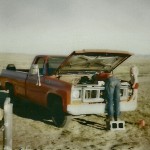
 For as long as I have known my husband, Bob Schulenberg, he has attracted the little girls. It surprises me every time I see it happen, although it probably shouldn’t by now. Bob got used to little girls when he became a daddy, first to our daughter, Corrie Petersen, and then our daughter, Amy Royce. They thought their daddy hung the moon, and I had to agree with them…he has always been a special kind of guy. Still, I can’t quite understand why it is always the little girls who tend to flock to Bob. It’s not little kids in general…it’s little girls. Of course, the little boys like him too…especially his grandsons, but the little boys are usually not the ones who come running up to Bob, or shyly wave at him, even when they don’t know him…that is the little girls. Of course, Bob would never pickup a little girl who was not the child of a friend, but that does not stop them from saying “Hi” and waving at him. Our own girls loved hanging out with their dad, and if he was working on a vehicle, they might be lifted up to stand on the bumper or they might be riding their bicycle nearby. Our grandchildren, Chris Petersen, Shai Royce, Caalab Royce, and Josh Petersen, also loved to be picked up by their Papa, and to this
For as long as I have known my husband, Bob Schulenberg, he has attracted the little girls. It surprises me every time I see it happen, although it probably shouldn’t by now. Bob got used to little girls when he became a daddy, first to our daughter, Corrie Petersen, and then our daughter, Amy Royce. They thought their daddy hung the moon, and I had to agree with them…he has always been a special kind of guy. Still, I can’t quite understand why it is always the little girls who tend to flock to Bob. It’s not little kids in general…it’s little girls. Of course, the little boys like him too…especially his grandsons, but the little boys are usually not the ones who come running up to Bob, or shyly wave at him, even when they don’t know him…that is the little girls. Of course, Bob would never pickup a little girl who was not the child of a friend, but that does not stop them from saying “Hi” and waving at him. Our own girls loved hanging out with their dad, and if he was working on a vehicle, they might be lifted up to stand on the bumper or they might be riding their bicycle nearby. Our grandchildren, Chris Petersen, Shai Royce, Caalab Royce, and Josh Petersen, also loved to be picked up by their Papa, and to this 
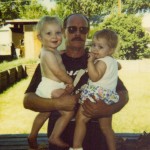 day, he is their go-to mechanic when something is wrong with their vehicles, or anything else he can help with.
day, he is their go-to mechanic when something is wrong with their vehicles, or anything else he can help with.
One little girl in particular, Brooke Cardinal, who passed away at seven and who we miss very much, was very taken with Bob. Her grandpa, our friend Edd Cardinal ran the bowling alley in Casper, and both our family and his spent a lot of time down there. Brooke couldn’t wait for Bob to come in on bowling nights. She was waiting at the door for her hug. I even teased her mom, Dani Cardinal that Bob had a girlfriend. She was ready to kill him for cheating on me, until she found out that his “girlfriend” was her own little Brooke, who was about four years old then. Bob was forgiven for having a girlfriend, but the “girlfriends” didn’t stop there. Whenever we go to a restaurant and there is a little girl around, they always notice and wave to Bob. When we are out walking on the trail, at Sunrise Shopping Center, or the mall, little girls wave. And on New Year’s Eve, the next generation of girlfriends obviously arrived, when my grandniece, Aleesia Spethman took a shine to Bob, and hung around him much of the night.


Bob is a great guy, with a gentle heart, and that is one of the things that attracted me to him in the first place, but never in a million years would I have expected that every little girl within a mile radius of him would seek him out for the sole purpose of saying “Hi” and waving at him. It’s almost like he is a little girl magnet. Some day, maybe I’ll figure out just what it is about Bob that catches their eye, but until that day, and even beyond, I’m sure, I will have to share him with every little girl who comes into view, because he sure attracts them.

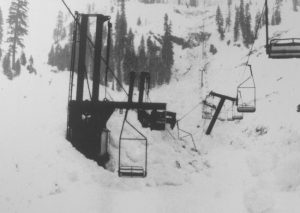 When we think of a series of disasters, it is usually tornadoes, earthquakes, or floods that come to mind. On February 11, 1952, none of the usual suspects were at fault in the series of disasters that began across central Europe. Snow storms don’t normally fall into the category of a series of disasters, but when a storm stalled over middle Europe during the first week of February of 1952, it dumped two feet of snow in parts of France, Austria, Switzerland, and Germany. In the vast area of middle Europe, life quickly ground to a standstill. Everything was closed, and travel was impossible. Germany recruited thousands of people and their shovels in an attempt to make the streets passable. In France several people died when their roofs collapsed under the weight of the heavy snow accumulation.
When we think of a series of disasters, it is usually tornadoes, earthquakes, or floods that come to mind. On February 11, 1952, none of the usual suspects were at fault in the series of disasters that began across central Europe. Snow storms don’t normally fall into the category of a series of disasters, but when a storm stalled over middle Europe during the first week of February of 1952, it dumped two feet of snow in parts of France, Austria, Switzerland, and Germany. In the vast area of middle Europe, life quickly ground to a standstill. Everything was closed, and travel was impossible. Germany recruited thousands of people and their shovels in an attempt to make the streets passable. In France several people died when their roofs collapsed under the weight of the heavy snow accumulation.
The worst of the storm, however, was felt in Austria, when a series od deadly avalanches took a heavy death toll. It was during the early hours of February 11, 1952, at a ski resort in Melkoede, when a huge mass of the newly fallen snow suddenly crashed down the mountain from above. There was no time to react, and no time to get away. They were trapped. Fifty people were sleeping at the resort. Twenty of them, mostly German tourists were killed, and another ten were seriously injured. In Switzerland and Austria, authorities issued urgent warnings about potential avalanches and some villages were actually evacuated. Nevertheless, all that was not enough. The next day there were more damaging avalanches. In Isenthal, Switzerland, hundreds of cattle and several barns were buried by an avalanche. In Leutasche, Austria, a twelve year old child was saved by people who risked their own lives in the face of a second avalanche that was poised to fall. Seven members of the child’s family were killed by the avalanche.
Avalanches kill more than 150 people worldwide each year. Most are snowmobilers, skiers, and snowboarders, and most deadly avalanches are triggered by the victim or someone in their party. Given that count, I suppose that the 78 people who perished in the February avalanches in middle Europe in 1952, might seem like a small number, but when you consider that these deaths occurred over a period of a few days, and the rest of the deaths by avalanches from that year were not included in that number, the death toll is staggering. This was not the worst avalanche death toll, however. That record, if it is right to call it such, goes to the Huascarán avalanche that was triggered by the 1970 Ancash earthquake in Peru. On 31 May 1970, the Ancash earthquake caused a substantial part of the north side of the mountain to collapse. The avalanche mass, an 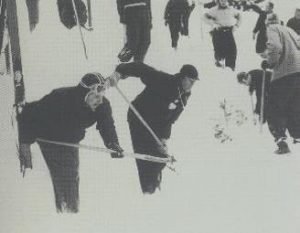
 estimated 80 million cubic feet of ice, mud and rock, was about half a mile wide and a mile long. It advanced about 11 miles at an average speed of 175 to 200 miles per hour, burying the towns of Yungay and Ranrahirca under ice and rock, killing more than 20,000 people. This avalanche, in my estimation, might have been more of a landslide than an avalanche, and so it’s very possible that all of these people would have died had there been snow or not.
estimated 80 million cubic feet of ice, mud and rock, was about half a mile wide and a mile long. It advanced about 11 miles at an average speed of 175 to 200 miles per hour, burying the towns of Yungay and Ranrahirca under ice and rock, killing more than 20,000 people. This avalanche, in my estimation, might have been more of a landslide than an avalanche, and so it’s very possible that all of these people would have died had there been snow or not.

